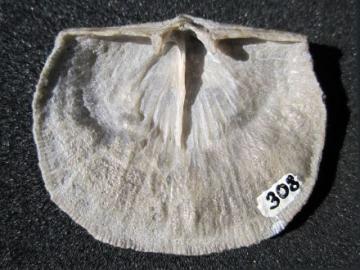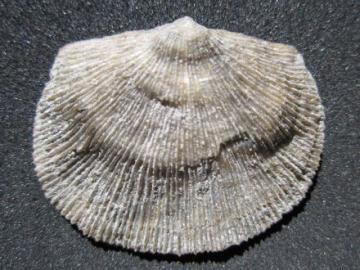Missouri Geological Survey Director: Carey Bridges, RG
The outer surface of brachiopod shells can be smooth, ribbed, ridged or spiny. The inner surface is mostly smooth with ridges, muscle scars and other markings that are used in classification and identification.


Brachiopods are a phylum of shelled, marine, invertebrate animals that came into existence during the earliest part of the Paleozoic Era about 520 million years ago and have persisted to present day. Their heyday, with more than 30,000 species, was during the Paleozoic Era that ended 250 million years ago, when a mass extinction wiped out most brachiopods, along with at least 90% of all life on Earth. About 400 species of brachiopods are living today. The shell of a brachiopod comprises a pedicle valve (ventral) and a brachial valve (dorsal). The two valves usually are shaped differently.
Both have a pointed beak. The valves are hinged together in their beak regions. The shell is opened and closed in clam-like manner by internal musculature. When a brachiopod shell is positioned with beaks top center, the left half of the shell mirrors the right half, which is a way of saying that brachiopod shells exhibit bilateral symmetry with respect to a plane that cuts perpendicularly through from beaked end to opposite end.
The pedicle valve contains a fleshy stalk (pedicle) that protrudes through an opening in the beak area and serves to anchor the shell to the seafloor.
The brachial valve contains a pair of ciliated appendages called brachia that serve to gather and move suspended food particles to the mouth. Scientists in the early 1800s originally thought the brachia function as feet for locomotion; hence, the name brachiopod, which was derived from the Greek words brachio (arm) and pod (foot). One group of brachiopods has tough, somewhat flexible shells made of organophosphatic material. The second group has hard, rigid shells made of calcium carbonate in the form of the mineral calcite. The modern day Lingula is an organophosphatic brachiopod. The modern day lamp shell is a calcitic brachiopod. Brachiopod habitat ranges from the intertidal zone down to 600 feet depth. They start life as free-swimming larvae. Then, they anchor themselves permanently to the seafloor and subsist by filter feeding. A brachiopod lifespan is 3 to 30 years.
Predators include snails, starfish, cephalopods, crustaceans and fish. The many kinds of now-extinct, shell-crusher, shark-like, cartilaginous fish that lived during the latter half of the Paleozoic Era would have been major predators.
Brachiopods and other fossils are on display in our Ed Clark Museum of Missouri Geology. They also are found in the limestone walls of the Capitol in Jefferson City.
Nothing in this document may be used to implement any enforcement action or levy any penalty unless promulgated by rule under chapter 536 or authorized by statute.
For more information
Geological Survey Program
Missouri Geological Survey
P.O. Box 250
Rolla, MO 65402-0250
United States
